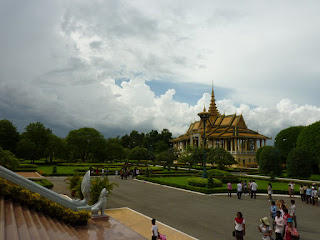
I was in Phnom Penh, Cambodia this spring, to play some piano concerts at the gracious invitation of my friend S. I always considered Cambodia an exotic destination if I considered it at all, and was really excited to explore this part of the world. The country has had a turbulent couple of decades in terms of civil war, wars with neighboring countries, and tragic genocides. Cambodia now seems to be growing again but signs of its recent past are everywhere. What is new there is very new. And then in striking contrast are the older parts and places.
The first image you see above is of the Royal Gardens which contain the Royal Palace and some temples as well. No where else in Cambodia did I see such a well maintained area. I was also struck by the mix of tourists and local people. It must be a regular destination for local Cambodians as well, as part of school or family trips.

This building above is the National Museum. Visually, the building itself was stunning. The collection was interesting, containing objects from many periods of Cambodia's past. Cambodia is home to the complex of temples known as Angkor Wat. This complex was actually a large city in it's day (ranging from 900 AD - 1100 AD ±) that at its height is estimated to have had almost one million inhabitants, this at a time when London had 55,000. Angkor Wat will be the subject of a later blog entry, but it's mentioned here because I found it strange to see so much at Angkor Wat, and then see examples of the same thing in cases on display in the National Museum!

Another example of some of the renovations taking place is the Central Market, seen above. It is originally from 1937. See the interior below. It struck me as really well designed in order to avoid or manage the heat and humidity.


Above is a street scene, on the same square as the post office building, but this image struck me as more colorful.

Here above you see the contrast between old and new, the old colonial building in a semi-ruined state, and the new bridge which covers a now filled in canal.

Above is another street scene with the electrical wiring and open-air- designed houses which are found everywhere in the city.

This is a picture of the room I slept in at my friend S.'s house. Such hospitality! The trip was amazing and Phnom Penh was just the beginning of it.
 These pictures are part of a series from my visit to Siem Reap in Cambodia. The name Angkor Wat is known amongst South East Asian history enthusiasts, but Angkor Wat is only one, albeit the largest of the temple complexes in and around Siem Reap. Angkor Thom is the name that refers to the ancient city that sits just a bit further down the road from Angkor Wat itself. The entrance to Angkor Thom is the gate you see above.
These pictures are part of a series from my visit to Siem Reap in Cambodia. The name Angkor Wat is known amongst South East Asian history enthusiasts, but Angkor Wat is only one, albeit the largest of the temple complexes in and around Siem Reap. Angkor Thom is the name that refers to the ancient city that sits just a bit further down the road from Angkor Wat itself. The entrance to Angkor Thom is the gate you see above.  Past the gate, the structure you come across is the Bayon. This one is noted for its gigantic Buddha heads incorporated into the towers.
Past the gate, the structure you come across is the Bayon. This one is noted for its gigantic Buddha heads incorporated into the towers.
 Interior hallway above, and skylight view below.
Interior hallway above, and skylight view below.

 This picture above is of the central tower of this temple
This picture above is of the central tower of this temple
 Small Buddhist shrines pop up regularly in these temple complexes. They are usually adorned with incense sticks, jasmine flowers, and candles.
Small Buddhist shrines pop up regularly in these temple complexes. They are usually adorned with incense sticks, jasmine flowers, and candles.




















